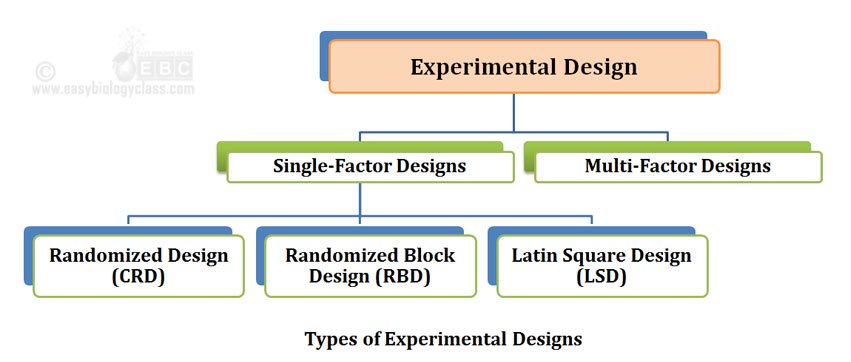C blocking blinding bias avoidance. Use enough subjects in each group to reduce chance variation in the results.

Design Of Experiments Examples Notes Easy Biology Class
The principle of replication.

. Statistical Principles of Research Design and Analysis by Robert O. Experimental design Basic principles 1. They hire a group of physical trainers and a statistician who recruits healthy adults.
The random allocation of treatments to the experimental units. In Statistics the experimental design or the design of experiment DOE is defined as the design of an information-gathering experiment in which a variation is present or not and it should be performed under the full control of the researcher. There are three basic principles behind any experimental design.
Experimental variable with control variable 1 or EV CV 1. Wide statistics literature on the subject. 21 - Simple Comparative Experiments.
Fisher there are three types of basic principle of experimental design. Basic Principles Z X Y We must control Z or include it. These principles make a valid test of significance possible.
23 - Determining Power. Three will be one second order interaction as well in the given design it is between all the three variables ie EV CV1 CV2. Ø The increased efficiency and reduced experimental errors in experimental designs are achieved by THREE basic principles.
The experiment should be reaped more than once. Control the effects of lurking variables on the response by ensuring all subjects are affected similarly by these lurking variables. An experiment is blinded if the subjects do not know which treatment group they are in.
A footwear company wants to test the effectiveness of its new insoles designed to prevent shin splints resulting from running. This term is generally used for controlled experiments. McFatter Psychology 415 - Experimental Psychology II Basic Principles in the Design and Evaluation of Experiments Robert M.
At one level the results may be interpreted. 22 - Sample Size Determination. Professor Fisher has enumerated three principles of experimental designs.
Randomly assign subjects to treatment groups. Basic principle of experimental design According to Prof. The first principle of an experimental design is randomization which is a random process of assigning treatments to the experimental units.
Randomization is the random process of assigning treatments to the experimental units. They are given below. Randomizeuse impersonal chance to assign subjects to treatments so treatment groups are similar on average.
Introduction to Design of Experiments. Randomize to avoid confounding between treatment effects and other unknown effects. McFatter University of Louisiana Lafayette The interpretation of statistical analyses of data derived from a study may be carried out at several levels.
11 - A Quick History of the Design of Experiments DOE 12 - The Basic Principles of DOE. 113 The Four Principles of Experimental Design 1. Then simply compare two or more treatments.
Ø They are classically called the Principles. The basic principles of statistical design of experiments are. The basic principles of experimental design are i Randomization ii Replication and iii Local Control.
Each of them is described briefly in the following subsections. The three basic principles of statistical design of experiments are A control comparison confounding. Control variable 1 with control variable 2 or CV1 CV2.
B control randomization repetition. Before examining specific experimental designs and the way that their data are analyzed we thought that it would be a good idea to review some basic principles of statistics. 115 - Principles of Experimental Design The following principles of experimental design have to be followed to enable a researcher to conclude that differences in the results of an experiment not reasonably attributable to chance are likely caused by the treatments.
Thus each treatment is applied in many experimental units instead of one. This allows us to equalize the effects of unknown or uncontrollable sources of variation. Reduce the experimental errors.
If relevant causes are NOT included in the. Control Experimental Blocking Matching Randomization Statistical ANCOVA Multiple Regression Structural Equations Theory and Scientific Judgment Simon. Replication means repetition of basic treatments under investigation.
For example A farmer wants to know whether new type of fertilizer will give him better yields. In a experiment we must control hold constant other possible causes of X. 1999 Design of Experiments Statistical Principles of Robert Kuehl s DESIGN OF EXPERIMENTS Second Edition prepares students to design and analyze experiments that will help them succeed in the real world.
Taguchi make it accessible to engineers and propagated a limited set of methods that simplified the use of orthogonal arrays. An experiment is double blind if both the subjects and the researchers measuring responses are unaware of the treatment group for each subject. Design of Experiments DoE is primarily covered in Section 5 Process.
We assume that most of you. Blinding is meant to protect against experimental artifacts that could. 13 - Steps for Planning Conducting and Analyzing an Experiment.
Randomization is the cornerstone underlying the use of statistical methods in experimental designs. The repetition of a treatment within an experiment allows. Increase the efficiency of design B.
Control sources of variation other than the factors being tested by making conditions as similar as possible for all treatment groups. Principles of experiment design. The basic principles of experimental designs are randomization replication and local control.
Purpose of Statistical Analysis In previous chapters we have discussed the basic principles of good experimental design. Experimental variable with control variable 2 or EV CV 2. Control the effects of lurking variables on the response most simply by comparing two or more treatments.
Randomize -- use chance to assign subjects to treatments. To quantify the natural variation between experimental units. Formulate questiongoal in advance 2.
By doing so the statistical accuracy of.

Design Of Experiments An Overview Sciencedirect Topics


0 Comments